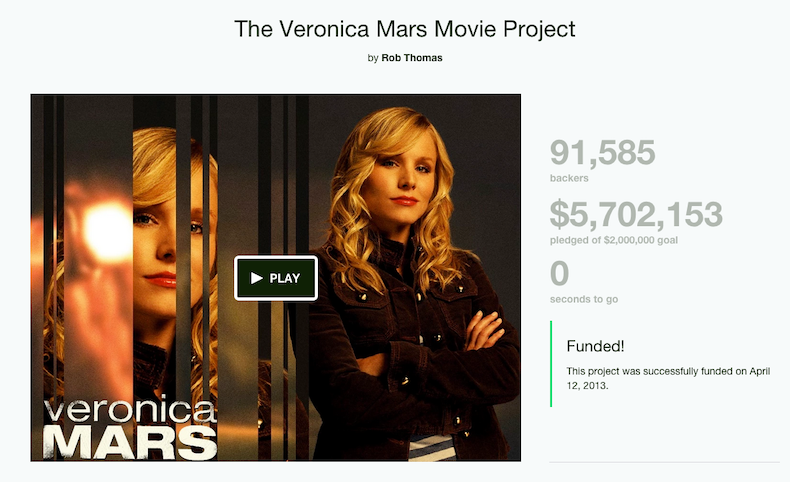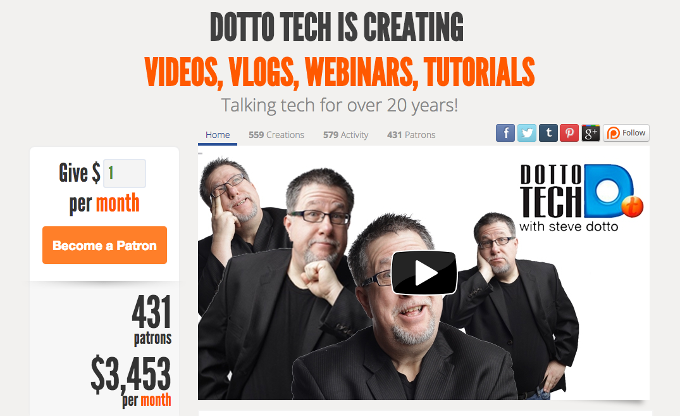This article was originally published in Reel West Magazine, and was republished here to archive it, after the close of the magazine.
Whether you laughed or exclaimed “WTF!” that a dude jokingly posts “I’m making potato salad. Basically I’m just making potato salad. I haven’t decided what kind yet.” on Kickstarter and he raises $55,492, it does make you sit up a little straighter and think maybe, just maybe, you should be paying crowdfunding a little more attention. What was Zack Danger Brown’s intention with his potato salad Kickstarter campaign, aside from a good chuckle? He’d publicly hoped to raise $10, while secretly his goal was $60. Never in his wildest dreams did he expect to raise $55,492. Who would?!?

As a creator, this excites me. Whether you’ve long been a fan of crowdfunding or have been skeptically watching from the sidelines, this past year has carried some telling examples with it for us creators. Examples that suggest crowdfunding may indeed be a viable alternative to play with in the Canadian film and TV funding game, opening the playing field up to those creators who are willing to put in the work to experiment with a new model of funding, sidestepping traditional gatekeepers.
After all, it is not just potato salad that is getting funded. 2013 saw a revival of the Veronica Mars stories, as after 7 years of being off network television, Director Rob Thomas, in a last ditch attempt to raise financing for the film started a Kickstarter campaign. He admittedly was skeptical if it would work. You see he needed $2 million to go to camera, and at that time the highest raising Kickstarter campaign had been $900,000. It would seem Rob need not have worried. He raised the first $1 million in the first 4 hours! By 12 hours in, he’d raised the $2 million that he needed to shoot. The campaign continued on to raise a total of $5,702,153 from 91,585 backers, unlocking a variety of the campaign’s stretch goals.

Many pondered whether this was just a one time phenomenon, but since then Reading Rainbow has been revived too, thanks to a Kickstarter campaign raising $5,408,916 (it’s goal was $1 million). Then this summer Coolest Cooler took over the torch of Kickstarter’s highest raising campaign yet raising $13,285,226, while it’s goal was only $50,000.
I hear a few mutters of “Well … those are big American entities, with pre-existing fan bases.” True enough, at least in the case of Veronica Mars and Reading Rainbow, but our Canadian creators’ campaigns are nothing to scoff at. Take for example Indie Game: the Movie, by Manitoba filmmakers James Swirsky and Lisanne Pajot – with two Kickstarter campaigns they raised $94,676 for the documentary. Their goal had been $50,000. They most certainly considered this a success, and in the process they had inadvertently marketed their documentary, creating a fan base and anticipation for it’s release. Win – Win!
Interviews with Canadian Creatives on Crowdfunding
In interviewing a number of other Canadian creatives who have successfully crowdfunded their own projects, here is what they learned in the process:
Steve Dotto
Past: Radio and TV Producer & Host, Now: YouTube Publisher
The Campaign:
After spending many years on network TV, I moved my product to YouTube. When I was in traditional television, my customer was the sponsor, my customer now, is my viewer, the purpose of a crowdfunding campaign is to create a direct connection between the viewer and content creator. Ideally I was looking to recapture some revenue, from my community. I have nearly 40,000 subscribers to my YouTube channel, a small contribution from each one would make for very healthy income. Community support allows me to create more compelling content that isn’t focused on pleasing advertisers instead of viewers.
Crowdfunding Platform of Choice:
The crowdfuding platform I am currently using is called Patreon (patreon.com/dottotech), It was designed to bring audiences and content creators together. By becoming a patron, an individual can choose to support an individual content creator, musician, artist, writer, or in my case YouTube Publisher. Crowdfunding closes the gap, and removes the middle man, so you don’t have to deal with networks or other publishers in order to reach your audience.
Patreon is one of the first on the market offering this sort of service. I think it is an outstanding option for any content creator. One caveat is YouTube is looking at offering similar services, and if they get into the game it could make for a compelling option.

Advice:
First, mature the product you are offering to the community. I think it is important to establish your brand and offer before asking people to invest in you.
Also I “primed the pump”. I did a small private campaign to get some activity in my account before asking the general public to support me. I think if people visit any online product and hear crickets, you will have a difficult time converting them into supporters.
Sarah Keenleyside
Inkblot Media (& Joseph Clement, Producer / Director of Auratic Media)
The Campaign:
I am helping produce a documentary about Integral House, one of the most architecturally significant homes in North America – and its owner Jim Stewart, who is the world’s most published calculus mathematicians. The house is remarkable, not only because of its stunning architecture by Shim Sutcliffe Architects, but also because it functions as a concert space and has hosted such celebrated musicians as Phillip Glass, Misha Breuggergosman and The New Orford Quartet.
After hitting a few frustrating dead ends while pursuing traditional financing, we quickly decided to fundraise the budget ourselves offering experiences within the house (concerts, an art event) as rewards for interested investors. So far Joseph has successfully hosted three events in the house, the proceeds of which have kept the production afloat.
Crowdfunding Platform of Choice:
We used none. Instead, Joseph created a site for the film where people could purchase tickets: auraticmedia.com/tickets. So far, all of the events have been well attended through word of mouth, but we will be doing a final, major concert or event in the house to complete our production funding, and then we’re hoping to go back to the traditional sources to help us finish it off.
Advice:
I think it’s important to ask yourself, why should people care about your project? What are investors getting out of the investment? Even $5 and the time it takes to donate $5 is a big ask based solely on your word that they will enjoy the film when it’s finished.
I think our campaign is highly unusual, because we can offer such desirable rewards, and because the rewards are so connected to the film itself. In a way, we didn’t need to prove that the film will be good – visiting the house is reward enough!
But I have given money to many campaigns in the past, and looking back, they all drew me in for very specific reasons – i.e. I was familiar with the person/people behind the campaign and I admired their previous work; I cared about the cause or subject matter featured in the film; I was curious about the subject matter; I liked their technical approach and wanted to see it realized; or the rewards were just so rewarding that I couldn’t resist (in most cases, the reward was a book that was being presold).
Daniel Baylis
Writer and Adventurer (and Digital Editor at Air Canada’s enRoute Magazine)
The Campaign:
A couple years ago, I turned 30 years old and decided to mark the occasion by travelling around the world for an entire year. The objective of my travels was not simply to drift, but to find meaningful ways to engage with the communities I visited. In some cases I succeeded. In other cases I did not. Upon returning to Canada, I began the process of writing a memoir about my journey. I decided to independently release this book, and crowdfunding became an integral (and obvious) step in the process of sharing my story with the world.
Now, you can see the book at thetraveller.ca: The Traveller: Notes from an Imperfect Journey Around the World.
Crowdfunding Platform of Choice:
I used Indiegogo and would absolutely use the platform again. They’ve got a support team in place that was responsive to any concerns. In fact, they provided unsolicited coaching tips that proved vital in my campaign. For example, I hit my $5000 goal within three days and Stephan from the service team encouraged me to set “stretch goals” to communicate how I could take my project further with more funding.
Advice:
Don’t rush into it. Take the time to plan out your attack, communicate your goal clearly and then make a stellar video.
Kemp Edmonds
Part-Time Filmmaker Kemp Edmonds (cbc.ca/player/Shows/ID/2303020192) advices that “its like politics: for success you need to ask anyone who you can to take part. You need to sell yourself and your campaign 24/7 to ensure success. Also build partnerships and have others feature what you are doing. Think PR. Think unique hook. Why does your story matter to the greater audience? How can you get a newspaper or radio reporter to jump on the story? Then use every social media channel you can you reach, engage and converse with folks, especially those with places to amplify your message, about your campaign.”
Doreen Pendgracs
And novelist Doreen Pendgracs (doreenpendgracs.com/?s=crowdfunding) suggests you study the algorithm of the crowdfunding platform you are on, so that you benefit from their help in marketing your campaign. She also advices you keep the video that you are using to promote your campaign short. She created one 8-minute video, that should have been two shorter videos.
Final Words
Just remember, don’t become greedy with your crowdfunding campaign, but do be realistic in your budgeting. Make sure that you are not overselling and can deliver what you are promising.
When you start your crowdfunding campaign, do be sure to tell us by tweeting us at @AhimsaMedia and / or using the #StoryToGo hashtag. We love seeing what our Canadian creatives are up to!
Leave a Reply